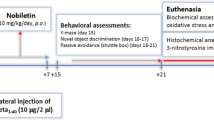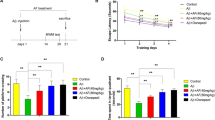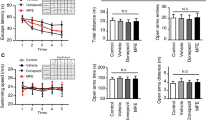Abstract
Antrodia camphorata is a particular and precious medicinal mushroom, and its fruiting body was found to provide more efficient protection from oxidative stress and inflammation than its mycelium because of its higher content of triterpenoids, total phenols, and so on. In the previous in vitro studies, the mycelium of A. camphorata is proven to provide strong neuroprotection in neuron cells and suggested to have the potential of protection against neurotoxicity of amyloid β-protein (Aβ) known as the risk factor toward Alzheimer’s disease (AD) development. However, the in vivo study and the comparison study with the fruiting body have not yet been investigated. This study compared the effect of the fruiting body and mycelium of A. camphorata on alleviating the Aβ40-induced neurocytotoxicity in the in vitro Aβ-damaged neuron cell model (PC-12 cell treated with Aβ40) and memory impairment in the in vivo AD animal model induced with a continuous brain infusion of Aβ40. In the results of in vitro and in vivo studies, the fruiting body possessed stronger anti-oxidative and anti-inflammatory abilities for inhibiting neurocytotoxicity in Aβ40-treated PC-12 cells and Aβ40 accumulation in Aβ40-infused brain than mycelium. Moreover, hyperphosphorylated tau (p-tau) protein expression, known as an important AD risk factor, was suppressed by the treatment of fruiting body rather than that of mycelium in the in vitro and in vivo studies. These comparisons supported the reasons why the fruiting body resulted in a more significant improvement effect on working memory ability than mycelium in the AD rats.








Similar content being viewed by others
References
Andersson BE, Tornberg K, Henrysson T, Olsson S (2001) Three-dimensional outgrowth of a wood-rotting fungus added to a contaminated soil from a former gasworks site. Bioresour Technol 78:37–45
Aniya Y, Yokomakura T, Yonamine M, Shimada K, Nagamine T, Shimabukuro M, Gibo H (1999) Screening of antioxidant action of various molds and protection of Monascus anka against experimentally induced liver injuries of rats. Gen Pharmacol 32:225–231
Ballatore C, Lee VM, Trojanowski JQ (2007) Tau-mediated neurodegeneration in Alzheimer's disease and related disorders. Nat Rev Neurosci 8:663–672
Boyd E (1935) The growth of the surface area of human body. University of Minnesota Press, Minneapolis
Chang CY, Lee CL, Pan TM (2006) Statistical optimization of medium components for the production of Antrodia cinnamomea AC0623 in submerged cultures. Appl Microbiol Biotechnol 72:654–661
Chen CC, Shiao YJ, Lin RD, Shao YY, Lai MN, Lin CC, Ng LT, Kuo YH (2006) Neuroprotective diterpenes from the fruiting body of Antrodia camphorata. J Nat Prod 69:689–691
Chen CH, Yang SW, Shen YC (1995) New steroid acids from Antrodia cinnamomea, a fungal parasite of Cinnamomum micranthum. J Nat Prod 58:1655–1661
Chen YJ, Cheng PC, Lin CN, Liao HF, Chen YY, Chen CC, Lee KM (2008) Polysaccharides from Antrodia camphorata mycelia extracts possess immunomodulatory activity and inhibits infection of Schistosoma mansoni. Int Immunopharmacol 8:458–467
Choi SJ, Kim MJ, Heo HJ, Kim HK, Hong B, Kim CJ, Kim BG, Shin DH (2006) Protective effect of Rosa laevigata against amyloid beta peptide-induced oxidative stress. Amyloid 13:6–12
Christen Y (2000) Oxidative stress and Alzheimer disease. Am J Clin Nutr 71:621S–629S
Cliffe S, Fawer MS, Maier G, Takata K, Ritter G (1994) Enzyme assays for the phenolic content of natural juices. J Agric Food Chem 42:1824–1828
Dubois M, Gilles K, Hamilton JK, Rebers PA, Smith F (1951) A colorimetric method for the determination of sugars. Nature 168:167
Dumont M, Wille E, Calingasan NY, Tampellini D, Williams C, Gouras GK, Liby K, Sporn M, Nathan C, Flint Beal M, Lin MT (2009) Triterpenoid CDDO-methylamide improves memory and decreases amyloid plaques in a transgenic mouse model of Alzheimer's disease. J Neurochem 109:502–512
Hashimoto M, Tanabe Y, Fujii Y, Kikuta T, Shibata H, Shido O (2005) Chronic administration of docosahexaenoic acid ameliorates the impairment of spatial cognition learning ability in amyloid beta-infused rats. J Nutr 135:549–555
Heo HJ, Kim DO, Choi SJ, Shin DH, Lee CY (2004) Potent inhibitory effect of flavonoids in Scutellaria baicalensis on amyloid beta protein-induced neurotoxicity. J Agric Food Chem 52:4128–4132
Hseu YC, Chang WC, Hseu YT, Lee CY, Yech YJ, Chen PC, Chen JY, Yang HL (2002) Protection of oxidative damage by aqueous extract from Antrodia camphorata mycelia in normal human erythrocytes. Life Sci 71:469–482
Hseu YC, Chen SC, Yech YJ, Wang L, Yang HL (2008) Antioxidant activity of Antrodia camphorata on free radical-induced endothelial cell damage. J Ethnopharmacol 118:237–245
Hsiao G, Shen MY, Lin KH, Lan MH, Wu LY, Chou DS, Lin CH, Su CH, Sheu JR (2003) Antioxidative and hepatoprotective effects of Antrodia camphorata extract. J Agric Food Chem 51:3302–3308
Huang NK, Cheng JJ, Lai WL, Lu MK (2005) Antrodia camphorata prevents rat pheochromocytoma cells from serum deprivation-induced apoptosis. FEMS Microbiol Lett 244:213–219
Iqbal K, Grundke-Iqbal I (2007) Developing pharmacological therapies for Alzheimer disease. Cell Mol Life Sci 64:2234–2244
Jin M, Shepardson N, Yang T, Chen G, Walsh D, Selkoe DJ (2011) Soluble amyloid beta-protein dimers isolated from Alzheimer cortex directly induce Tau hyperphosphorylation and neuritic degeneration. Proc Natl Acad Sci USA 108:5819–5824
Lee CL, Kuo TF, Wang JJ, Pan TM (2007) Red mold rice ameliorates impairment of memory and learning ability in intracerebroventricular amyloid beta-infused rat by repressing amyloid beta accumulation. J Neurosci Res 85:3171–3182
Lee CL, Kuo TF, Wu CL, Wang JJ, Pan TM (2010) Red mold rice promotes neuroprotective sAPPalpha secretion instead of Alzheimer's risk factors and amyloid beta expression in hyperlipidemic Abeta40-infused rats. J Agric Food Chem 58:2230–2238
Lee CL, Tsai TY, Wang JJ, Pan TM (2006) In vivo hypolipidemic effects and safety of low dosage Monascus powder in a hamster model of hyperlipidemia. Appl Microbiol Biotechnol 70:533–540
Lee CL, Wang JJ, Pan TM (2008) Red mold rice extract represses amyloid beta peptide-induced neurotoxicity via potent synergism of anti-inflammatory and antioxidative effect. Appl Microbiol Biotechnol 79:829–841
Lee IH, Huang RL, Chen CT, Chen HC, Hsu WC, Lu MK (2002) Antrodia camphorata polysaccharides exhibit anti-hepatitis B virus effects. FEMS Microbiol Lett 209:63–67
Li MH, Jang JH, Sun B, Surh YJ (2004) Protective effects of oligomers of grape seed polyphenols against beta-amyloid-induced oxidative cell death. Ann N Y Acad Sci 1030:317–329
Liu DZ, Liang HJ, Chen CH, Su CH, Lee TH, Huang CT, Hou WC, Lin SY, Zhong WB, Lin PJ, Hung LF, Liang YC (2007) Comparative anti-inflammatory characterization of wild fruiting body, liquid-state fermentation, and solid-state culture of Taiwanofungus camphoratus in microglia and the mechanism of its action. J Ethnopharmacol 113:45–53
Long MS, Hong Y, Zhou XH, Yang Y (2006) Anti-dementia effects of grape peel extracts experiment study. Wei Sheng Yan Jiu 35:300–303
Lu MK, Cheng JJ, Lai WL, Lin YJ, Huang NK (2008) Fermented Antrodia cinnamomea extract protects rat PC12 cells from serum deprivation-induced apoptosis: the role of the MAPK family. J Agric Food Chem 56:865–874
Mulder C, Verwey NA, van der Flier WM, Bouwman FH, Kok A, van Elk EJ, Scheltens P, Blankenstein MA (2010) Amyloid-beta(1–42), total tau, and phosphorylated tau as cerebrospinal fluid biomarkers for the diagnosis of Alzheimer disease. Clin Chem 56:248–253
Ohkawa H, Ohishi N, Yagi K (1979) Assay for lipid peroxides in animal tissues by thiobarbituric acid reaction. Anal Biochem 95:351–358
Oyaizu M (1986) Antioxidative activity of browning products of glucosamine fractionated by organic solvent and thin-layer chromatography. Nippon Shokuhin Kogyo Gakkaishi 35:771–775
Paris D, Mathura V, Ait-Ghezala G, Beaulieu-Abdelahad D, Patel N, Bachmeier C, Mullan M (2011) Flavonoids lower Alzheimer's Abeta production via an NFkappaB dependent mechanism. Bioinformation 6:229–236
Paxinos G, Watson C (2005) The rat brain in stereotaxic coordinates: the new coronal set. Elsevier Academic, London
Rhein V, Song X, Wiesner A, Ittner LM, Baysang G, Meier F, Ozmen L, Bluethmann H, Drose S, Brandt U, Savaskan E, Czech C, Gotz J, Eckert A (2009) Amyloid-beta and tau synergistically impair the oxidative phosphorylation system in triple transgenic Alzheimer's disease mice. Proc Natl Acad Sci USA 106:20057–20062
Sastre M, Klockgether T, Heneka MT (2006) Contribution of inflammatory processes to Alzheimer's disease: molecular mechanisms. Int J Dev Neurosci 24:167–176
Scott HD, Laake K (2001) Statins for the prevention of Alzheimer's disease. Cochrane Database Syst Rev CD003160.
Shen YC, Chou CJ, Wang YH, Chen CF, Chou YC, Lu MK (2004) Anti-inflammatory activity of the extracts from mycelia of Antrodia camphorata cultured with water-soluble fractions from five different Cinnamomum species. FEMS Microbiol Lett 231:137–143
Shen YC, Yang SW, Lin CS, Chen CH, Kuo YH, Chen CF (1997) Zhankuic acid F: a new metabolite from a formosan fungus Antrodia cinnamomea. Planta Med 63:86–88
Smith MA, Rottkamp CA, Nunomura A, Raina AK, Perry G (2000) Oxidative stress in Alzheimer's disease. Biochim Biophys Acta 1502:139–144
Stephan A, Phillips AG (2005) A case for a non-transgenic animal model of Alzheimer's disease. Genes Brain Behav 4:157–172
Wang CN, Chen JC, Shiao MS, Wang CT (1991) The inhibition of human platelet function by ganodermic acids. Biochem J 277(Pt 1):189–197
Wilkinson K, Boyd JD, Glicksman M, Moore KJ, El Khoury J (2011) A high-content drug screen identifies ursolic acid as an inhibitor of amyloid-{beta} interactions with its receptor CD36. J Biol Chem
Yu YL, Chen IH, Shen KY, Huang RY, Wang WR, Chou CJ, Chang TT, Chu CL (2009) A triterpenoid methyl antcinate K isolated from Antrodia cinnamomea promotes dendritic cell activation and Th2 differentiation. Eur J Immunol 39:2482–2491
Zhu YZ, Huang SH, Tan BK, Sun J, Whiteman M, Zhu YC (2004) Antioxidants in Chinese herbal medicines: a biochemical perspective. Nat Prod Rep 21:478–489
Author information
Authors and Affiliations
Corresponding author
Rights and permissions
About this article
Cite this article
Wang, LC., Wang, SE., Wang, JJ. et al. In vitro and in vivo comparisons of the effects of the fruiting body and mycelium of Antrodia camphorata against amyloid β-protein-induced neurotoxicity and memory impairment. Appl Microbiol Biotechnol 94, 1505–1519 (2012). https://doi.org/10.1007/s00253-012-3941-3
Received:
Revised:
Accepted:
Published:
Issue Date:
DOI: https://doi.org/10.1007/s00253-012-3941-3




